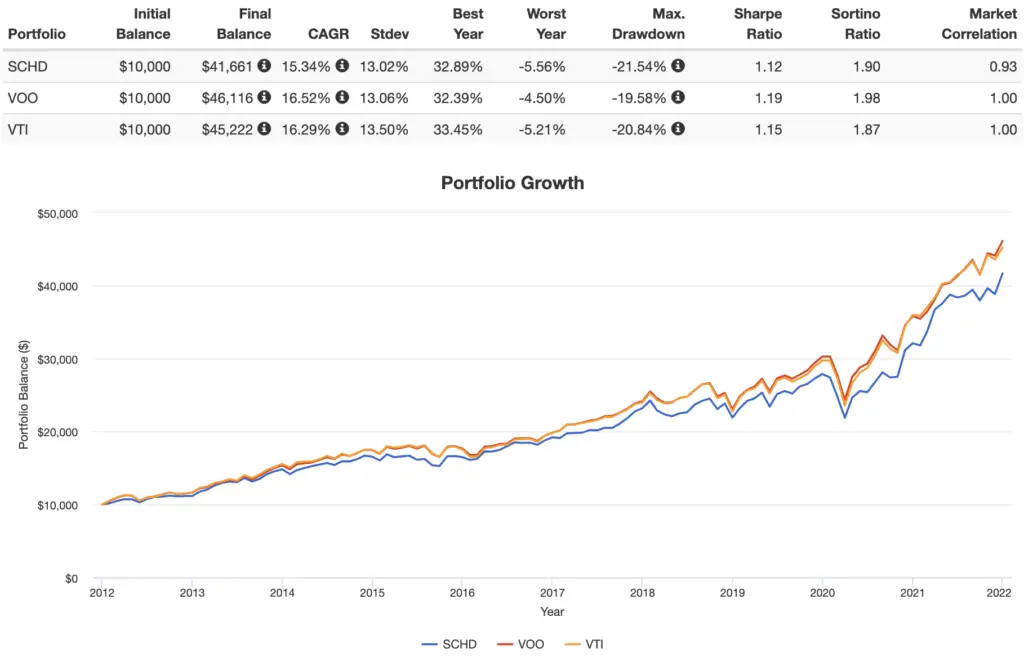SCHD is a popular dividend ETF from Schwab. VOO and VTI are broad market index funds from Vanguard for the S&P 500 and total U.S. stock market. Let's compare them.
Disclosure: Some of the links on this page are referral links. At no additional cost to you, if you choose to make a purchase or sign up for a service after clicking through those links, I may receive a small commission. This allows me to continue producing high-quality content on this site and pays for the occasional cup of coffee. I have first-hand experience with every product or service I recommend, and I recommend them because I genuinely believe they are useful, not because of the commission I may get. Read more here.
In a hurry? Here are the highlights:
- SCHD is a popular dividend fund from Schwab.
- VOO and VTI are very popular broad U.S. stock funds from Vanguard.
- SCHD tracks the Dow Jones U.S. Dividend 100 Index. VOO tracks the S&P 500 Index. VTI tracks the CRSP US Total Market Index.
- As such, SCHD is solely U.S. dividend stocks, VOO is U.S. large-cap stocks, and VTI is essentially VOO plus small- and mid-cap stocks.
- VOO and VTI include REITs; SCHD does not.
- VOO and VTI are much more diversified than SCHD.
- VOO and VTI outperformed SCHD going back to SCHD's inception in 2011. Historical performance of VTI and VOO has been nearly identical.
- VOO and VTI are more popular and slightly cheaper than SCHD.
- SCHD is likely unsuitable as a core holding in a well-diversified investment portfolio.
Contents
Video
Prefer video? Watch it here:
SCHD vs. VOO and VTI – Methodology and Composition
We can compare SCHD to both VOO and VTI simultaneously, as both VOO and VTI are representative of “the market” in the U.S. and their performance is nearly identical. VOO seeks to track the famous S&P 500 Index, the 500 largest publicly traded companies in the U.S., and VTI tracks the entire U.S. stock market. I compared VOO and VTI here.
SCHD, the Schwab U.S. Dividend Equity ETF, is a narrower segment of the market than VOO or VTI. The fund is a very popular dividend ETF from Schwab that launched in late 2011. SCHD has a little over 100 holdings and aims to capture companies with a reliable dividend history and robust profitability. Its market cap weighted index is the Dow Jones U.S. Dividend 100 Index.
Though it may appear so at first glance, SCHD is not just your typical, simple dividend fund. It uses fundamental screens like ROE, dividend growth rate, and debt to equity ratios to identify high-quality companies and thus provides appreciable exposure to equity risk factors like Profitability and Investment, as well as non-trivial exposure to the Value factor.
VOO is the Vanguard S&P 500 ETF, and it's one of the most popular ETFs in existence. Established in 2010, the fund seeks to track the market cap weighted S&P 500 Index, holding over 500 U.S. large-cap stocks. This index is considered a proxy for the U.S. stock market.
VTI is the Vanguard Total Stock Market ETF. It was established in 2001 and seeks to track the CRSP US Total Market Index. VTI provides similar broad exposure to the U.S. stock market, but also includes small- and mid-cap stocks. Specifically, about 82% of VTI's 3,500 holdings are large cap stocks, 12% are mid cap stocks, and 6% are small cap stocks. Thus, VOO is about 82% of VTI by weight.
Sector weightings are naturally very different for SCHD than for VOO or VTI:
| SCHD | VOO | |
| Basic Materials | 2.8% | 2.8% |
| Consumer Staples | 14.7% | 6.8% |
| Consumer Discretionary | 7.5% | 11.5% |
| Financials | 19.6% | 10.9% |
| Healthcare | 13.1% | 14.2% |
| Industrials | 15.8% | 7.8% |
| Energy | 5.9% | 4.2% |
| Technology | 14.9% | 27.4% |
| Telecommmunications | 5.4% | 8.6% |
| Utilities | 0.4% | 2.9% |
| Real Estate | 0.0% | 2.9% |
Notice how SCHD heavily overweights Consumer Staples, Financials, and Industrials relative to the market. These sectors are notorious for reliable dividends and strong profitability. Also note how SCHD has zero or low exposure to Utilities and Real Estate.
As such, SCHD alone would not be considered sufficient as a core holding for a well diversified investment portfolio, and should probably only be used to tilt, or overweight, high-quality dividend-paying stocks in one's portfolio. This may be attractive for dividend investors; I'm not a dividend investor, but I did design a dividend-focused portfolio that incorporates SCHD as its primary holding.
SCHD vs. VOO and VTI – Historical Performance
Going back to 2011 when SCHD launched, VOO and VTI have beaten it with only slightly greater volatility:

SCHD vs. VOO & VTI – AUM and Fees
Though all three of these funds are highly liquid and very popular, Vanguard's VOO and VTI are much more popular than SCHD with over $550 billion and $900 billion in assets, respectively, compared to about $36 billion for SCHD.
SCHD has an expense ratio of 0.06%, while both VOO and VTI are cheaper with an expense ratio of 0.03%.
Conclusion
Investors seeking broad, diversified exposure to the U.S. stock market should use VOO or VTI as a core holding. SCHD only looks at high-profitability companies in the U.S. with a reliable dividend history, and is thus likely better suited as a dividend tilt for those looking to use dividend yield as income or those who want a someone naive yet non-trivial tilt toward equity risk factors like Value, Investment, and Profitability.
VOO and VTI have outperformed SCHD going back to SCHD's inception in 2011 and are also slightly cheaper than SCHD.
Conveniently, all these funds should be available at any major broker, including M1 Finance, which is the one I'm usually suggesting around here.
Disclosure: I am long VOO in my own portfolio.
Disclaimer: While I love diving into investing-related data and playing around with backtests, this is not financial advice, investing advice, or tax advice. The information on this website is for informational, educational, and entertainment purposes only. Investment products discussed (ETFs, mutual funds, etc.) are for illustrative purposes only. It is not a research report. It is not a recommendation to buy, sell, or otherwise transact in any of the products mentioned. I always attempt to ensure the accuracy of information presented but that accuracy cannot be guaranteed. Do your own due diligence. I mention M1 Finance a lot around here. M1 does not provide investment advice, and this is not an offer or solicitation of an offer, or advice to buy or sell any security, and you are encouraged to consult your personal investment, legal, and tax advisors. Hypothetical examples used, such as historical backtests, do not reflect any specific investments, are for illustrative purposes only, and should not be considered an offer to buy or sell any products. All investing involves risk, including the risk of losing the money you invest. Past performance does not guarantee future results. Opinions are my own and do not represent those of other parties mentioned. Read my lengthier disclaimer here.

Are you nearing or in retirement? Use my link here to get a free holistic financial plan and to take advantage of 25% exclusive savings on financial planning and wealth management services from fiduciary advisors at Retirable to manage your savings, spend smarter, and navigate key decisions.

Leave a Reply